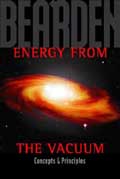| The Tom Bearden Website |
Subject: RE: New Scientist article Date: Fri, 10 Feb 2006 11:58:10 -0600 Thanks Earle! Very interesting, and we'll take a look at it. Just as a casual comment, they MAY have run into experiments which also involve the production and use of Dirac holes and hole currents, in addition to the normal currents. These are currents of negative-mass-energy electrons whose associated EM fields are negative energy EM fields. Bedini uses such in his overunity systems, particularly in very rapid battery charging. Incidentally, negative mass-energy Dirac holes ARE NOT positrons, and they ARE the "dark matter" that the astrophysicists are so avidly seeking. Their associated negative energy EM fields and potentials are the "dark energy" they are seeking. Maybe with the new work the physicists will finally realize what dark energy and dark matter really are, and that these can be evoked in lab circuits and their peculiar phenomenology studied first-hand. Best wishes, Tom Subject: New Scientist article Date: Fri, 10 Feb 2006 Hello. Jan.28-Feb 3, 2006 page 40: " The Quantum Cocktail" . Perhaps this might relate to your email on the magnetic motor since it deals with a breakdown in our understanding of superconductivity, electron currents and magnetism. An experimental setup( a combination of ytterbium, rhodium and silicon at very, very near absolute zero) is arrived at in which there should not be any electric current but there is!! There is even speculation that the electron might have broken up into 2 parts, one that carries the charge and another that caries the spin. All of this occurs under the conditions of near absolute zero temperature and strong magnetic fields. According to the standard Lev Landau "quasi-particle" model, the electrical resistance should increase as the square of the temperature but in this new experimental setup the resistance increases in a linear manner. To quote a physicist who reviewed the research: "From the traditional perspective, this behavior is utterly unreasonable". The possible explanation given is that this situation involves a phase transition that is not triggered by temperature since you are at nearly absolute zero but by the fluctuations of virtual particles in the quantum vacuum. Measurements of specific heat and resistivity tell us that electrons have come to a halt in these materials but there is still an electric current. So what is carrying the current? The suggestion is somekind of transitory charge carriers without a permanent existence has been postulated coming in 3 possible forms: 1) charged virtual particles 2) a composite "natural" particle made up of electrons but with properties dictated by the quantum critical state and 3) the breakdown of the electron into a charge carrier and a spin carrier with the spin part staying with the "body" of the traditional electron which now acts as if its inertial mass is 1000 times heavier than usual. However one physicist commented that we are now dealing with something completely unknown, perhaps there is some kind of "hidden order". Earle. |
